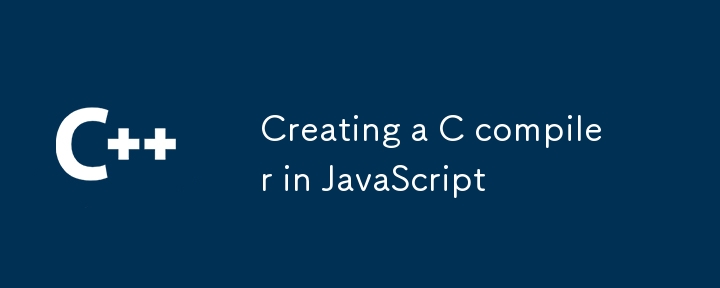

Das Erstellen eines C-Compilers in JavaScript ist ein komplexes und ehrgeiziges Projekt, das mehrere Komponenten umfasst, darunter lexikalische Analyse, Analyse, semantische Analyse und Codegenerierung. Nachfolgend finden Sie ein vereinfachtes und allgemeines Beispiel dafür, wie Sie mit der Erstellung eines solchen Compilers beginnen können. Dieses Beispiel konzentriert sich auf die Phasen der lexikalischen Analyse (Tokenisierung) und des Parsings, die die ersten Schritte beim Kompilieren von C-Code sind.
Der lexikalische Analysator (Lexer) wandelt den eingegebenen C-Code in einen Token-Stream um.
class Lexer {
constructor(input) {
this.input = input;
this.tokens = [];
this.current = 0;
}
tokenize() {
while (this.current < this.input.length) {
let char = this.input[this.current];
if (/\s/.test(char)) {
this.current++;
continue;
}
if (/[a-zA-Z_]/.test(char)) {
let start = this.current;
while (/[a-zA-Z0-9_]/.test(this.input[this.current])) {
this.current++;
}
this.tokens.push({ type: 'IDENTIFIER', value: this.input.slice(start, this.current) });
continue;
}
if (/[0-9]/.test(char)) {
let start = this.current;
while (/[0-9]/.test(this.input[this.current])) {
this.current++;
}
this.tokens.push({ type: 'NUMBER', value: this.input.slice(start, this.current) });
continue;
}
switch (char) {
case '+':
this.tokens.push({ type: 'PLUS', value: '+' });
this.current++;
break;
case '-':
this.tokens.push({ type: 'MINUS', value: '-' });
this.current++;
break;
case '*':
this.tokens.push({ type: 'STAR', value: '*' });
this.current++;
break;
case '/':
this.tokens.push({ type: 'SLASH', value: '/' });
this.current++;
break;
case '=':
this.tokens.push({ type: 'EQUAL', value: '=' });
this.current++;
break;
case ';':
this.tokens.push({ type: 'SEMICOLON', value: ';' });
this.current++;
break;
case '(':
this.tokens.push({ type: 'LPAREN', value: '(' });
this.current++;
break;
case ')':
this.tokens.push({ type: 'RPAREN', value: ')' });
this.current++;
break;
default:
throw new TypeError('Unexpected character: ' + char);
}
}
return this.tokens;
}
}
Der Parser wandelt den Tokenstrom in einen abstrakten Syntaxbaum (AST) um.
class Parser {
constructor(tokens) {
this.tokens = tokens;
this.current = 0;
}
parse() {
let ast = {
type: 'Program',
body: []
};
while (this.current < this.tokens.length) {
ast.body.push(this.parseStatement());
}
return ast;
}
parseStatement() {
let token = this.tokens[this.current];
if (token.type === 'IDENTIFIER' && this.tokens[this.current + 1].type === 'EQUAL') {
return this.parseAssignment();
}
throw new TypeError('Unknown statement: ' + token.type);
}
parseAssignment() {
let identifier = this.tokens[this.current];
this.current++; // skip identifier
this.current++; // skip equal sign
let value = this.parseExpression();
this.expect('SEMICOLON');
return {
type: 'Assignment',
identifier: identifier.value,
value: value
};
}
parseExpression() {
let token = this.tokens[this.current];
if (token.type === 'NUMBER') {
this.current++;
return {
type: 'Literal',
value: Number(token.value)
};
}
throw new TypeError('Unknown expression: ' + token.type);
}
expect(type) {
let token = this.tokens[this.current];
if (token.type !== type) {
throw new TypeError('Expected ' + type + ' but found ' + token.type);
}
this.current++;
}
}
Schließlich konvertiert der Codegenerator den AST in die Zielsprache, bei der es sich um JavaScript oder eine andere Sprache handeln kann.
class CodeGenerator {
generate(node) {
switch (node.type) {
case 'Program':
return node.body.map(statement => this.generate(statement)).join('\n');
case 'Assignment':
return `let ${node.identifier} = ${this.generate(node.value)};`;
case 'Literal':
return node.value;
default:
throw new TypeError('Unknown node type: ' + node.type);
}
}
}
So können Sie den Lexer, Parser und Codegenerator verwenden:
const input = `x = 42;`;
const lexer = new Lexer(input);
const tokens = lexer.tokenize();
console.log('Tokens:', tokens);
const parser = new Parser(tokens);
const ast = parser.parse();
console.log('AST:', JSON.stringify(ast, null, 2));
const generator = new CodeGenerator();
const output = generator.generate(ast);
console.log('Output:', output);
Dadurch wird die Eingabe tokenisiert, in einen AST analysiert und JavaScript-Code aus dem AST generiert.
Dieses Beispiel ist stark vereinfacht und behandelt nur eine kleine Teilmenge der C-Sprache. Ein vollwertiger C-Compiler würde die Handhabung eines viel größeren Satzes von Token, das Parsen komplexer Ausdrücke, Anweisungen, Deklarationen und Typen sowie die Generierung komplexerer Codes erfordern.
Das obige ist der detaillierte Inhalt vonErstellen eines C-Compilers in JavaScript. Für weitere Informationen folgen Sie bitte anderen verwandten Artikeln auf der PHP chinesischen Website!
 MySQL-Ausnahmelösung
MySQL-Ausnahmelösung
 Seriennummer der pscs5-Installation
Seriennummer der pscs5-Installation
 Computersprachen
Computersprachen
 Ethereum-Browser fragt digitale Währung ab
Ethereum-Browser fragt digitale Währung ab
 Windows kann nicht auf den angegebenen Gerätepfad oder die angegebene Dateilösung zugreifen
Windows kann nicht auf den angegebenen Gerätepfad oder die angegebene Dateilösung zugreifen
 Welche Dateitypen gibt es?
Welche Dateitypen gibt es?
 Welche Möglichkeiten gibt es, Shell-Skripte auszuführen?
Welche Möglichkeiten gibt es, Shell-Skripte auszuführen?
 So verwenden Sie Google Voice
So verwenden Sie Google Voice




